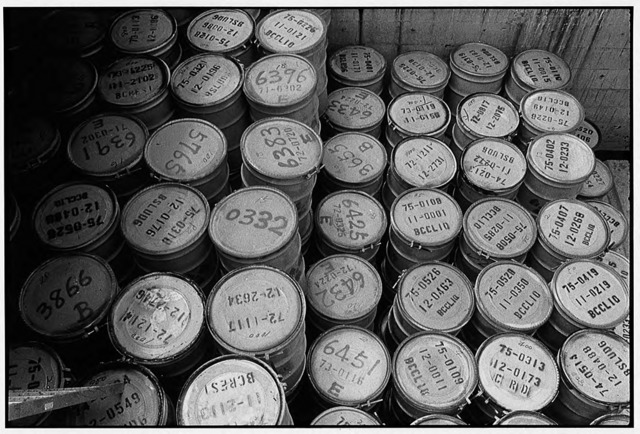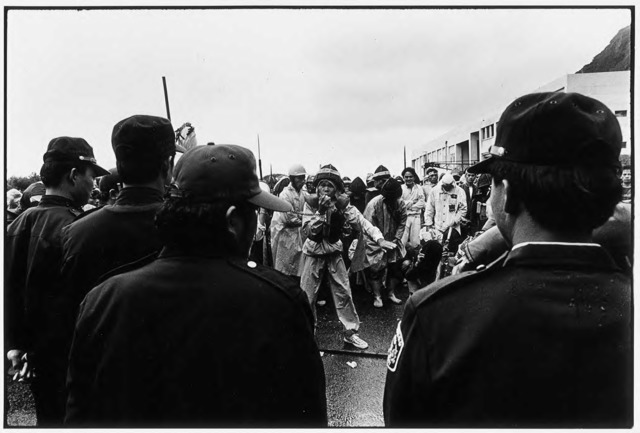Nuclear Waste Out of Lanyu: Indigenous Indignation in Taiwan Seen through Guan Xiao-Rong’s Photographs
Skip other details (including permanent urls, DOI, citation information)
: This work is licensed under a Creative Commons Attribution-NonCommercial-NoDerivatives 3.0 License. Please contact [email protected] to use this work in a way not covered by the license.
For more information, read Michigan Publishing's access and usage policy.
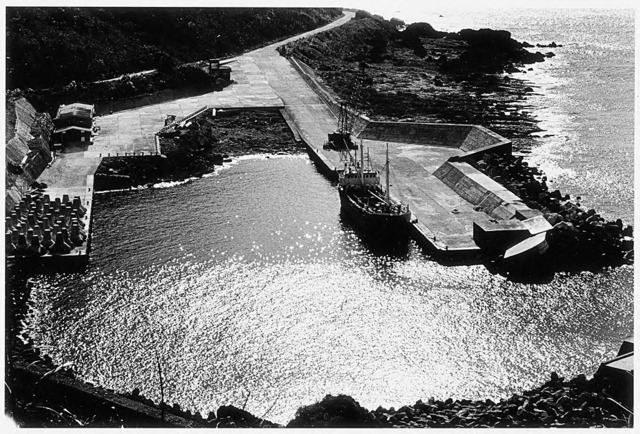 Guan Xiao-rong, The pier where nuclear waste shipped from Taiwan is unloaded, © Guan Xiao-rong, courtesy the artist.
Guan Xiao-rong, The pier where nuclear waste shipped from Taiwan is unloaded, © Guan Xiao-rong, courtesy the artist. Lanyu, a small Pacific island southeast of Taiwan, is the home of some five thousand Tao (or Yami) indigenous inhabitants and a few Han[1] Taiwanese residents. Although Lanyu has long been proud of its beautiful natural environment and traditional Yami culture, since 1982 it has been forced to import nuclear waste from Taiwan. In this scandalous coercion to be the storage site of this toxic waste, the Taiwanese government never discussed the scheme with Yami residents nor acquired their permission.
Guan Xiao-Rong, a Han photographer from Taiwan, involved himself deeply in documenting the political, economic, and environmental deprivations of the Yami people as created by Taiwan’s dominant Han government.
Despite being Han himself, and an outsider, in 1987 Guan stayed on this remote island for the entire year. During this period he established a close comradeship with the Yami people, investigating the devastating environmental, social, and cultural policies put into effect by the Taiwanese Han government. His work resulted in the publication of three volumes, entitled Dignity and Humiliation: A Marginalized Territory in Lanyu, which together contain nine photographic essays and eleven reports. In these reports, Guan provides clear historical accounts and critical investigations of the structural elements regarding the ordeal and despair of the Yami people. One of the photographic essays discusses the movement of resistance against the KMT[2] government’s choice of Lanyu as the storage site for nuclear waste.
As a documentary photographer, Guan took a position of critical partiality and mixed roles which required constant dialectic shifting. While writing “How Many ‘State Secrets’ Could Lanyu Bury Away?” Guan became involved in the anti–nuclear waste campaign, which had been initiated by several educated young Yami people. At times he took the role of an active participant and organizer, then quickly shifted back to his role as documentary photographer and took pictures.
The 1987 campaign did not prevent the Taiwan government from keeping the storage site in Lanyu and shipping tens of thousands of barrels filled with nuclear waste to the small island. However, the movement and the photographs had far-reaching effects in awakening a collective consciousness among the Yami people, who eventually forced the Taiwan government to a commitment that would remove the waste from Lanyu to a more remote, uninhabited island.
Today, the movement against nuclear power plants is a major social campaign in Taiwan itself, led by several committed Taiwanese NGO groups, especially since the 2011 nuclear power plant catastrophe in Japan, and Yami delegates from Lanyu join these huge annual demonstrations. Regrettably, the nuclear waste sites remain on Lanyu, a nightmare from which the Yami people so far have not been able to escape, and Guan, for personal reasons, did not continue tracking the issue with his photography.
Nevertheless, Guan’s work from the 1980s remains a model of in-depth, engaged documentary photography. He presents progressive political perspectives in its reports, which offer a structural understanding of the social deterioration and cultural invasion of Lanyu’s Yami by the Han majority. Guan’s photographs of Lanyu function in a realist mode,, which has inevitable limitations when speaking of complex truths. Nevertheless, with substantial analytic work and a clear political vision in his accompanying texts, he has made a radical documentary of irreducible political significance for Taiwanese society.
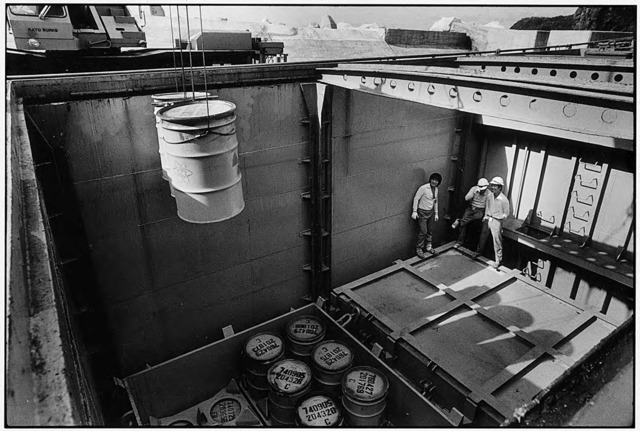 Guan Xiao-rong, Barrels containing nuclear waste are submerged in the storage tank, © Guan Xiao-rong, courtesy the artist.
Guan Xiao-rong, Barrels containing nuclear waste are submerged in the storage tank, © Guan Xiao-rong, courtesy the artist. 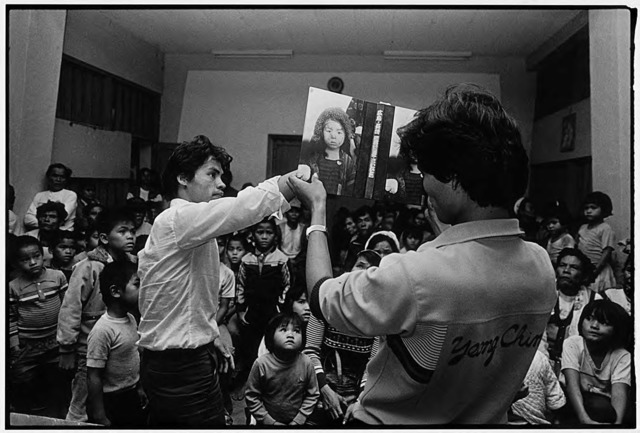 Guan Xiao-rong, Educated young native Yami men show to villagers and children the aftermath of 1945’s nuclear bombing of Japan, © Guan Xiao-rong, courtesy the artist.
Guan Xiao-rong, Educated young native Yami men show to villagers and children the aftermath of 1945’s nuclear bombing of Japan, © Guan Xiao-rong, courtesy the artist. 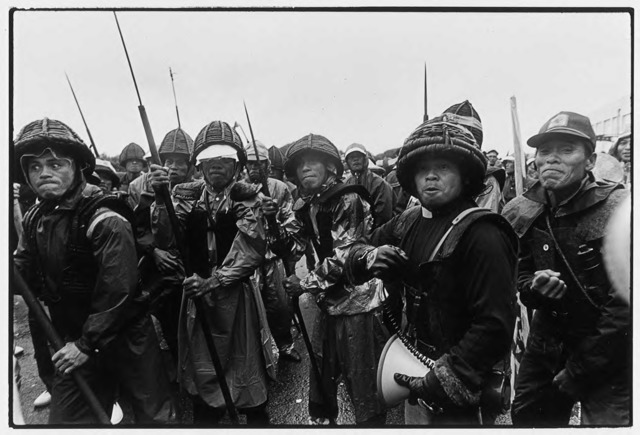 Guan Xiao-rong, Yami indigenous residents wear their traditional warrior outfits and position themselves in a fighting stance, © Guan Xiao-rong, courtesy the artist.
Guan Xiao-rong, Yami indigenous residents wear their traditional warrior outfits and position themselves in a fighting stance, © Guan Xiao-rong, courtesy the artist. 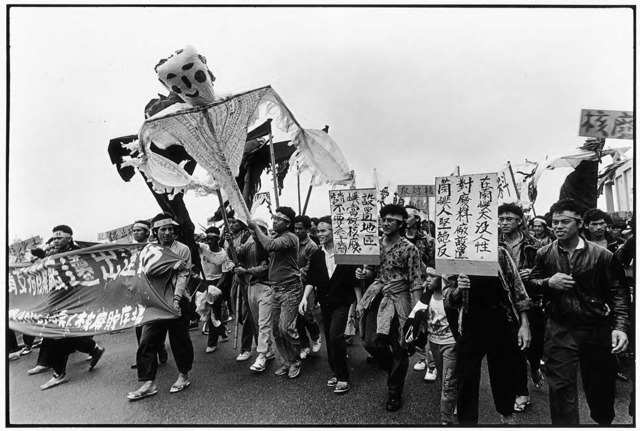 Guan Xiao-rong, The demonstration proceeds with posters and puppets that symbolize nuclear disaster, © Guan Xiao-rong, courtesy the artist.
Guan Xiao-rong, The demonstration proceeds with posters and puppets that symbolize nuclear disaster, © Guan Xiao-rong, courtesy the artist.  Guan Xiao-rong, Three young Yami leaders of the demonstration discuss following strategies on location, © Guan Xiao-rong, courtesy the artist.
Guan Xiao-rong, Three young Yami leaders of the demonstration discuss following strategies on location, © Guan Xiao-rong, courtesy the artist. 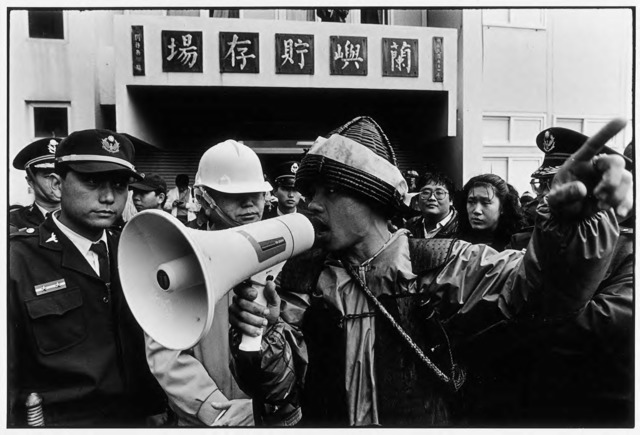 Guan Xiao-rong, Chen Jian-Ping, one of the Yami demonstration leaders, argues with police in front of the main office building of the site of nuclear waste storage, © Guan Xiao-rong, courtesy the artist.
Guan Xiao-rong, Chen Jian-Ping, one of the Yami demonstration leaders, argues with police in front of the main office building of the site of nuclear waste storage, © Guan Xiao-rong, courtesy the artist. 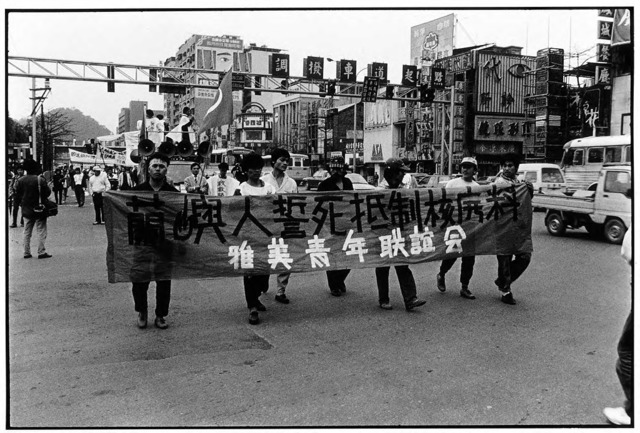 Guan Xiao-rong, The Yami Youth Association extends its anti–nuclear waste demonstration to Taipei, seat of the Taiwanese government, © Guan Xiao-rong, courtesy the artist.
Guan Xiao-rong, The Yami Youth Association extends its anti–nuclear waste demonstration to Taipei, seat of the Taiwanese government, © Guan Xiao-rong, courtesy the artist. 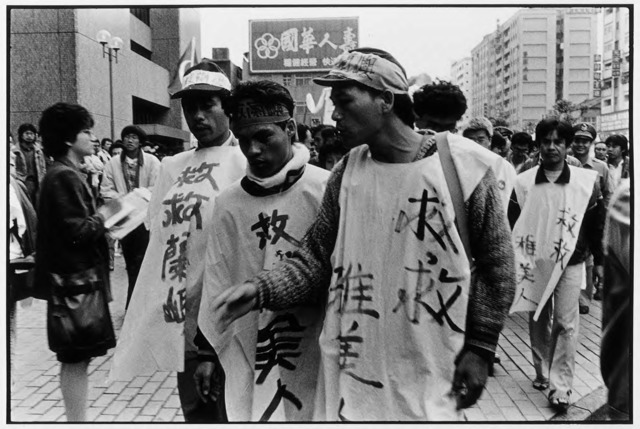 Guan Xiao-rong, Indigenous demonstrators, in front of the headquarters of the Taiwan Power Company, wear clothing that reads “Help Yami people”, © Guan Xiao-rong, courtesy the artist.
Guan Xiao-rong, Indigenous demonstrators, in front of the headquarters of the Taiwan Power Company, wear clothing that reads “Help Yami people”, © Guan Xiao-rong, courtesy the artist.  Guan Xiao-rong, Local demonstrators hold signposts that say “Nuclear waste out of Lanyu”, © Guan Xiao-rong, courtesy the artist.
Guan Xiao-rong, Local demonstrators hold signposts that say “Nuclear waste out of Lanyu”, © Guan Xiao-rong, courtesy the artist. Kuo Li-Hsin is Associate Professor in the College of Communication, National Chengchi University, Taiwan. His recent publications include More Writings on Photography (2013, in Chinese), and Investigating Realities: Politics and De-politicization of Documentary Film (2014, in Chinese).


